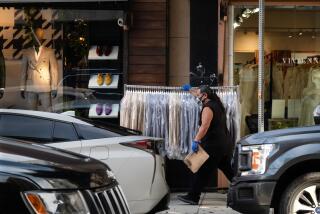Dry Cleaning Gender Gap Still Rubs
- Share via
It’s a de-pressing situation: Women in Southern California are finding they pay more than men do for dry cleaning, a per-item gap that can amount to as much as $1.25.
Although many dry cleaners slowly are changing the practice, others still cling to the varied charges, saying it is an issue that affects their purses. They claim it takes more time and labor to clean women’s versus men’s clothes.
But, replies Dady Blake, head of the Los Angeles chapter of the National Organization for Women: “There is no excuse for any dry cleaner in this city to charge a woman more for a shirt to be laundered than a man, or any other article of clothing for that matter.”
Actually, it isn’t the cleaning but the pressing that provides the rub in the sexes’ laundry bill, dry cleaners say. Initial costs to clean a regular cotton, Oxford shirt are about the same for men and women.
But women are taken to the cleaners when the shirt goes to press. That’s because industry standard pressing machines have been designed and made for years to accommodate men’s, not women’s clothes. Women’s shirts--sizes 14 and under--don’t fit most machines and must be hand pressed, a “time-consuming” task, dry cleaners say.
New Machine Needed
They insist they have been pressing manufacturers to design a machine to handle smaller shirts.
At least one company already has marketed such a machine--since the 1950s. Forenta, a Tennessee manufacturer, created the Bantam presser especially to handle clothes for women, children and smaller men, said Jim Onkst, a sales coordinator for the company. He notes the unit “has been selling very well for the past four years.”
Why the recent surge in interest? “More dry cleaners are starting to see that shirt laundry is a profit-making business. And both men and women are a part of it.
“In past years,” he says, “a lot of dry-cleaning businesses would send their laundry out-of-house to be cleaned. Now you’re seeing those businesses doing the laundry in-house to control the cost. And they need the machinery to do it.”
The Bantam, Onkst says, does have one drawback, relative to other standard dry-cleaning machines: It presses only 20 shirts an hour, as opposed to the 50 garments the standard units can handle.
But even with special machinery, some dry cleaners insist they still must charge women more because they bring in so many different styles of blouses that need special care.
“The problem is that ladies’ garments are not tailored the same as men’s,” says Burt Baker, manager for the A Company Cleaners on West Olympic Boulevard. “They often have ruffles or pleats or bows that you have to press by hand. And it takes a lot of work.”
Though that may be true, dry cleaners need to adjust to changes in the times, Blake says, adding, “Women are a part of the professional work force just like men . . . and have been for years. It’s time to change the business . . . not the business to change the way women dress.”
The California Fabricare Institute of Drycleaners and Launderers started that process in 1987, said George Laumann, its executive director, who noted “a fair-pricing guideline has already been established by our board of directors to help eliminate price discrimination.” The recommendations urge member cleaners to review pricing policies and base them on labor and supply costs. It states that “prices should never be based upon . . . gender,” though Laumann noted the guidelines are strictly advisory in nature and his group has no power to enforce them.
In Washington, a group of George Washington University Law School students and their professor got steamed enough about dry-cleaning disparities to press executives to reconsider the issue. Just last week, two major Washington dry-cleaning associations agreed to urge theirmembers not to discriminate on the basis of sex for cleaning fees.
The agreement was part of a settlement with the professor and students, who had found that Washington women were charged from a quater to $4.60 more per item than men for cleaning.
More to Read
Inside the business of entertainment
The Wide Shot brings you news, analysis and insights on everything from streaming wars to production — and what it all means for the future.
You may occasionally receive promotional content from the Los Angeles Times.










